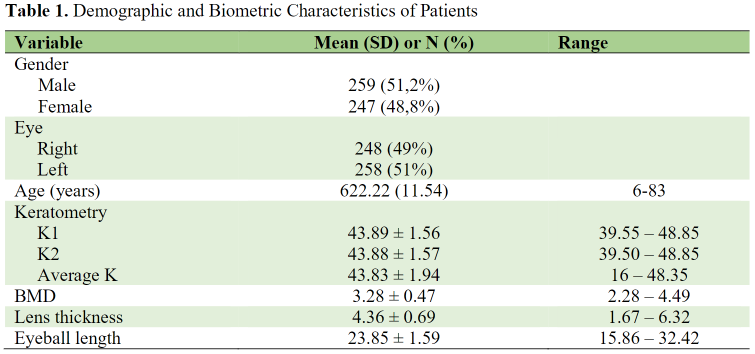THE USE OF VISUAL FUNCTION INDEX-14 (VF-14) QUESTIONNAIRE IN DETERMINING CATARACT PATIENTS’ QUALITY OF LIFE IN JONGGOL SUBDISTRICT, INDONESIA
Abstract
Introduction and Objective: Unresolved cataract primarily has caused patients to have disturbance in carrying out daily activities, thus lowering their quality of life (QoL). We aim to use the Visual Function Index-14 (VF-14) questionnaire, one of the most frequently used tools, to discover the extent of daily activities disturbance in patients with cataract.
Methods: In this observational study, we conducted eye screening to 47 subjects in Jonggol subdistrict, Bogor, Indonesia. Patients were asked several questions based on the translated VF-14 questionnaire into Bahasa and also tested to find out their best-corrected visual acuities. Lens examination was carried on using handheld slit lamp.
Result: Out of all 47 subjects, 34 (72,3%) patients had cataract that was marked by lens opacities in either one or both eyes. According to distant vision impairment categories by International Classification of Diseases 11, 8,8% of cataract patients had normal vision from the better eye, 20,6% had mild, 64,7% had moderate, 0% had severe impairment, and 5,9% had blindness. From the assessment using VF-14 translated questionnaire, 14,7% subjects had no disruption in doing daily activities, 82,3% had disruption, and 2,9% could not do the mentioned activities at all. From the Spearman correlation test, there was a significant association with moderate correlation between the degree of vision impairment and QoL (p = 0.006, rs = 0.459).
Conclusion: The majority of cataract patients in Jonggol subdistrict had moderate vision impairment and had disruption in doing daily activities, therefore lowering their QoL.
Full text article
References
Lutfah R, Aldiana H, Yeni D L, Nila F M, Hans. Blindness and visual impairment situation in Indonesia based on rapid assessment of avoidable blindness surveys in 15 provinces. Ophthalmic Epidemiol. 2020; p. 1-12. doi:10.1080/09286586.2020.1853178
Fang, R., Yu, YF., Li, EJ. et al. Global, regional, national burden and gender disparity of cataract: Findings from the global burden of disease study 2019. BMC Public Health. 2022; p. 2068. doi: 10.1186/s12889-022-14491-0
Wan Y, Zhao L, Huang C, Xu Y, Sun M, Yang Y, et al. Validation and comparison of the National Eye Institute Visual Functioning Questionnaire-25 (NEI VFQ-25) and the Visual Function Index-14 (VF-14) in patients with cataracts: a multicentre study. Acta Ophthalmol. 2020; 99(4) p. 1-9; doi: 10.1111/aos.14606.
Amedo AO, Koomson NY, Pascal TM, Kumah DB, et al. Quality of life of cataract patients before and after surgery-evidence from four rural communities in Ghana. Mathews J Ophthalmol. 2016; 1(1): 003.
Angeles Han, Griffin K W, Harrison M J, Lehman T J, Leong T, Robb R et al. Development of a vision-related quality of life instrument for children ages 8-18 years for use in juvenile idiopathic arthritis-associated uveitis. Arthritis Care Res (Hoboken). 2011. p. 1254-61. doi: 10.1002/acr.20524.
Chiang PP, Fenwick E, Marella M, et al. Validation and reliability of the VF-14 questionnaire in a German population. Investig Ophthalmol Vis Sci. 2011; 52 (12) p. 8919. doi:10.1167/iovs.11-7702
ICD-11 for mortality and morbidity statistics: 9D90 Vision impairment including blindness. World Health Organization [Internet]. 2023 [cited 2023 May 19]. Available from: https://icd.who.int/browse11/l-m/en#/http://id.who.int/icd/entity/1103667651
Khadka J, McAlinden C, Pesudovs K. Quality assessment of ophthalmic questionnaires: review and recommendations. Optom Visi Sci. 2013; 98 (8), p. 720-744. doi: 10.1097/OPX.0000000000000001
Finger RP, Kupitz DG, Holz FG, Balasubramaniam B, Ramani RV, Lamoureux EL, et al. The impact of the severity of vision loss on vision-related quality of life in India: an evaluation of the IND-VFQ-33. Investig Ophthalmol Vis Sci. 2011; 52 (9), p. 6081. doi: 10.1167/iovs.11-7388
Polack S, Eusebio C, Fletcher A, Foster A, et al. Visual impairment from cataract and health related quality of life: results from a case-control study in the Philippines. Ophthalmic Epidemiol. 2010; 17 (3), p. 152-159. doi: 10.3109/09286581003731536
Salim FP. Korelasi antara visual field index dengan kualitas hidup penderita glaukoma menggunakan kuesioner NEI-VFQ 25. Bandung: Pusat Mata Nasional Rumah Sakit Mata Cicendo Fakultas Kedokteran Universitas Padjadjaran; 2020.
Steinberg EP, Tielsch JM, Schein OD, Javitt JC, et al. The VF-14 an index of functional impairment in patients with cataract. Arch Ophthalmol. 1994; 112(5), p. 630. doi: 10.1001/archopht.1994.01090170074026
Authors
Copyright (c) 2024 Nadya Safira, Muhammad Keyvan Fermitaliansyah, Syska Widyawati, Mutmainah Mahyuddin

This work is licensed under a Creative Commons Attribution-NonCommercial-ShareAlike 4.0 International License.



